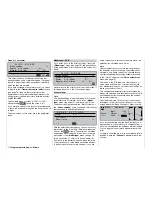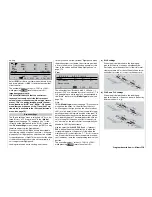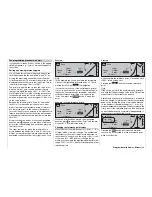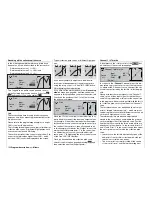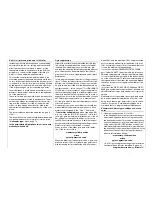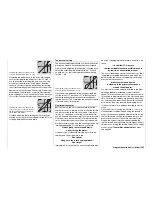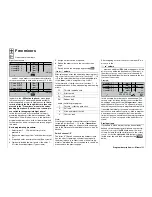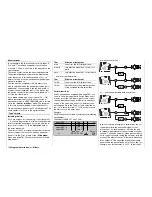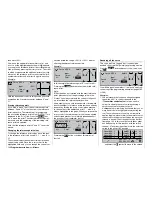
128
Program description:
Mixers
50% suppression gyro gain is reduced to half if the
assigned transmitter control is moved to the +50%
position (as shown here); and at >150% suppres-
sion gain is reduced to zero before full tail rotor
defl ection with the slider at this position.
2. Linear gyro suppression with reduced control tra-
vel, e. g. -50% to +80% travel. Gyro gain can be
varied proportionally within these control limits.
Here again, for demonstration purposes the dia-
gram shows gyro gain varying according to tail ro-
tor defl ection for various values of the gyro sup-
pression parameter.
Adjusting the gyro sensor
If you are aiming at setting up a gyro to achieve ma-
ximum possible stabilisation of the helicopter around
the vertical axis, please note the following points:
• The control system should be as free-moving and
accurate (slop-free) as possible.
• There should be no “spring” or “give” in the tail ro-
tor linkage.
• You must use a powerful and – above all – fast
servo.
When the gyro sensor detects a deviation in yaw, the
faster it adjusts the thrust of the tail rotor, the further
the gyro gain adjustor can be advanced without the
tail of the model starting to oscillate, and the better
the machine’s stability around the vertical axis. If the
corrective system is not fast enough, there is a dan-
ger that the model’s tail will start to oscillate even at
low gyro gain settings, and you then have to reduce
gyro gain further to eliminate the oscillation.
If the model is fl ying forward at high speed, or ho-
vering in a powerful headwind, the net result of the
stabilising effect of the vertical fi n combined with the
gyro’s stabilising infl uence may be an over-reaction
which manifests itself in tail oscillation. In order to ob-
tain optimum stabilisation from a gyro in all fl ight situ-
ations, gyro gain can be adjusted from the transmitter
control assigned to Input “7” in conjunction with gyro
suppression and / or the two adjustors on the NEJ-
120 BB gyro.
Additional notes on gyros with multi-stage variable
gyro gain (e.g. NEJ-120 BB)
Since you cannot pre-set gyro gain proportionally at
the transmitter using the assigned transmitter cont-
rol, it makes sense to set the lower level of gyro gain
using adjustor 1 (e. g. for aerobatics), and the high-
er level of gain using adjustor 2 (e. g. for hovering). In
this case you can only switch between these two set
values, even if a proportional control is used for func-
tion 7, i. e. proportional adjustment is not available.
For this reason you should advance adjustor 2 to the
point where the model is on the brink of oscillating
when hovering in calm conditions, and advance ad-
justor 1 to the point where the model’s tail does not
oscillate when the model is at maximum speed and
fl ying in a powerful headwind. Depending on the wea-
ther conditions and the type of fl ying you wish to do,
you can then switch gyro gain to the appropriate set-
ting from the transmitter, and set gyro suppression to
vary according to movement of the tail rotor control if
you wish.
Swashplate rotation
With some rotor head control systems it is necessa-
ry to incline the swashplate in a direction which is not
the same as the intentional inclination of the rotor pla-
ne when a cyclic control command is given. For ex-
ample, if your model features the HEIM mechani-
cal system and is fi tted with a four-bladed main ro-
tor, the control linkage needs to be rotated to the right
through 45° by the software so that the pushrods from
the swashplate to the rotor head can be set exactly
vertical, ensuring that the blade control system works
correctly, without unwanted differential effects. This
menu point provides for this arrangement, and elimi-
nates the need to make mechanical changes to the
control linkages. Negative angles equate to a virtual
rotation of the rotor head to the left; positive angles a
virtual rotation to the right.
Pressing
CLEAR
resets the input value to “0°”.
Swashplate limiting
This function works like a circular mechanical sur-
round acting upon the stick which controls the swash-
plate, restricting the normally square stick travel to a
circular range. If the helicopter is set up in such a way
that the travels for roll and / or pitch-axis (elevator) ex-
ploit the maximum which is mechanically possible,
e. g. for 3-D aerobatic fl ying, then the swashplate will
tilt to much greater angles than normal if full roll and
pitch-axis commands are applied simultaneously; the
calculated maximum is 141%. At this point the swash-
plate mechanism may strike its end-stops, and in the
128
m i n
m a x
0 %
5 0 %
1 0 0 %
1 5 0 %
1 9 9 %
+ 5 0 %
- 1 0 0 %
Exemple:
+50%
Range of
tr
ansmitter
control 7
left
centre
right
Stick defl ection tail rotor
Gyro gain
m i n
m a x
1 3 0 %
1 9 9 %
5 0 %
1 9 9 %
+ 8 0 %
- 5 0 %
Exemple:
+80%
left
centre
right
Stick defl ection tail rotor
Gyro gain
Range of
tr
ansmitter
control 7
Summary of Contents for mx-24s
Page 1: ...1...
Page 19: ...19 For your notes...
Page 35: ...35 For your notes...
Page 41: ...41 41 For your notes...
Page 57: ...57 For your notes...
Page 63: ...63 63 For your notes...
Page 69: ...69 69 For your notes...
Page 85: ...85 85 For your notes...
Page 99: ...99 For your notes...
Page 143: ...143 For your notes...
Page 191: ...191 For your notes...
Page 212: ...212 212 For your notes...
Page 213: ...213 213 For your notes...
Page 214: ...214 For your notes...
Page 216: ...216...

